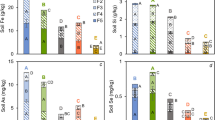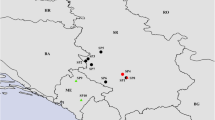Abstract
Phragmites australis (the common reed) was collected at six sites in southern Québec and Ontario, Canada, in order to study the accumulation of iron plaque on the roots. The deposition of iron oxides on roots ofP. australis did not correlate directly with soil measurements; however, the amounts of iron-bound-to-carbonates fraction of the soil/sediment, responsible for the iron plaque accumulation, correlated with the % of water, % of organic matter, % of clay and pH of the substrate. Plants located very near flowing water accumulated more iron plaque on the roots than plants in other habitats through the summer; it is hypothesized that carbonates associated with iron come from the flowing water. In wetlands or sites near flowing water, most root iron was found on the surface, as iron plaque, while there was more iron inside the root in dry environments. Radial oxygen loss from the roots is probably the most important source of oxygen for the oxidation of iron.
Similar content being viewed by others
References
Ando T, Yoshida S and Nishiyama I 1983 Nature of oxidizing power of rice roots. Plant and Soil 72, 57–71.
Armstrong W 1970 Rhizosphere oxidation of rice and other species: A mathematical model based on the oxygen flux component. Physiol. Plant. 23, 623–630.
Armstrong W and Boatman D J 1967 Some field observations relating the growth of bog plants to conditions of soil aeration. J. Ecol. 55, 101–110.
Bienfait H F, van den Briel M L and Mesland-Mul N T 1984 Measurement of the extracellular mobilizable iron pool in roots. J. Plant Nutr. 7, 659–665.
Bienfait H F, van den Briel W and Mesland-Mul N T 1985 Free space iron pools in roots: Generation and mobilization. Plant Physiol. 78, 596–600.
Carroll D 1958 Role of clay minerals in the transportation of iron.In Geochemistry of Iron. Ed. H. Lepp 1975. pp 110–116. Dowden, Hutchinson and Ross, Inc. Pennsylvania.
Conlin T S S 1986 Examination of Rhizospheric Oxidation and its Relation to Iron Toxicity inCarex rostrata Stokes,Typha latifolia L. andPhragmites australis (Cav.) MSc. thesis, Queen’s University, Kingston, Ontario, Canada, 193 p.
Crowder A A and Macfie S M 1986 Seasonal deposition of ferric hydroxide plaque on roots of wetland plants. Can. J. Bot. 64, 2120–2124.
Dagnelie P 1975 Analyse Statistique à plusieurs Variables. Les Presses Agronomiques de Gembloux, Belgique, 362 p.
Förstner U and Wittman G T W 1983 Metal pollution in the aquatic environment. Springer-Verlag, Berlin, 486 p.
Green M S and Etherington J R 1977 Oxidation of ferrous iron by rice (Oryza sativa L.) roots: A mechanism for waterlogging tolerance? J. Exp. Bot. 28, 678–690.
Håkanson L and Jansson M 1983 Principles of Lake Sedimentology. Springer-Verlag, Berlin, 316 p.
Johnson-Green, P C 1988 Interactions Between the Rhizoplane Microflora and Iron Oxide Deposition on Rice (Oryza sativa) roots. MSc thesis, Queen’s University, Kingston, Ontario, Canada, 90 p.
Kilmer V J and Alexander L T 1949 Methods of making mechanical analysis of soils. Soil Sci. 68, 15–24.
Konrad J G, Chesters G and Keeney D R 1970 Determination of organic- and carbonate-carbon in freshwater lake sediments by a microcombustion procedure. J. Thermal Anal. 2, 199–208.
Macfie S M 1986 Wetland Influence on Ferric Hydroxide Plaque Formation. MSc thesis, Queen’s University, Kingston, Ontario, Canada, 107 p.
Macfie S M and Crowder A A 1987 Soil factors influencing ferric hydroxide plaque formation on roots ofTypha latifolia L. Plant and Soil 102, 177–184.
McCarthy L 1985 Differences in the Formation on Iron Plaques in Two Clones ofTypha latifolia. BSc thesis, Queen’s University, Kingston, Ontario, Canada, 39 p.
Mendelssohn I A and Postek M T 1982 Elemental analysis of deposits on the roots ofSpartina alterniflora Loisel. Am. J. Bot. 69, 904–912.
Norrish K 1975 Geochemistry and mineralogy of trace elements.In Trace Elements in Soil-Plant-Animal Systems. Eds. D J D Nicholas and A R Egan. pp 55–81. Academic Press Inc., New-York.
Peech M 1965 Hydrogen-ion activity.In Methods of Soil Analysis. Part two: Chemical and Microbiological Properties. Eds. C A Black, D D Evans, J L White, L E Ensminger and F E Clark. pp 914–926. Amer. Soc. Agron., Madison, Wisconsin.
Ponnamperuma P N 1972 The chemistry of submerged soils. Adv. Agron. 24, 29–96.
Rodden R 1983 Iron Plaques inTypha latifolia Roots: A Structural Study. BSc thesis, Queen’s University, Kingston, Ontario, Canada, 57 p.
St-Cyr L and Crowder A A 1988 Iron oxide deposits on the roots ofPhragmites australis related to the iron bound to carbonates in the soil. J. Plant Nutr. 11, 1253–1262.
St-Cyr L and Crowder A A 1989 Mn and Cu in the root plaque ofPhragmites australis (Cav.) Trin. ex Steudel. Soil Science.
Taylor G J and Crowder A A 1983 Use of the DCB technique for extraction of hydrous iron oxides from roots of wetland plants. Am. J. Bot. 70, 1254–1257.
Tessier A, Campbell P G C and Bisson M 1979 Sequential extraction procedure for the speciation of particulate trace metals. Anal. Chem. 51, 844–851.
Trolldenier G 1987 Oxidizing power of rice roots as related to plant nutrition. XIV International Botanical Congress, Berlin, Germany. Abstract 1-24-7, p. 36.
Vale C, Catarino F M, Cortesao C and Caçador M I 1988 Presence of metal-rich rhizoconcretions of the roots ofSpartina maritima from the salt-marshes Tagus estuary. International Symposium on the Fate and Effects of Toxic Chemicals in large rivers and their estuaries, Québec, Canada. Abstract.
Wetzel R G 1983 Limnology: Second edition. Saunders College Publishing, 767 p.+R81+I10.
Yamada N and Ota Y 1958 Study on the respiration of crop plants (7) Enzymatic oxidation of ferrous iron by root of rice plant. Proc. Crop Sci. Soc. Japan 26, 205–210.
Yamasaki S 1984 Role of plant aeration in zonation ofZizania latifolia andPhragmites australis. Aquat. Bot. 18, 287–297.
Yoshida T 1975 Microbial metabolism of flooded, soils.In Soil Biochemistry, Volume 3. Eds. E A Paul and A D McLaren. pp 83–122. Marcel Dekker Inc., New-York.
Author information
Authors and Affiliations
Rights and permissions
About this article
Cite this article
St-Cyr, L., Crowder, A.A. Factors affecting iron plaque on the roots ofPhragmites australis (Cav.) Trin. ex Steudel. Plant Soil 116, 85–93 (1989). https://doi.org/10.1007/BF02327260
Received:
Revised:
Issue Date:
DOI: https://doi.org/10.1007/BF02327260




